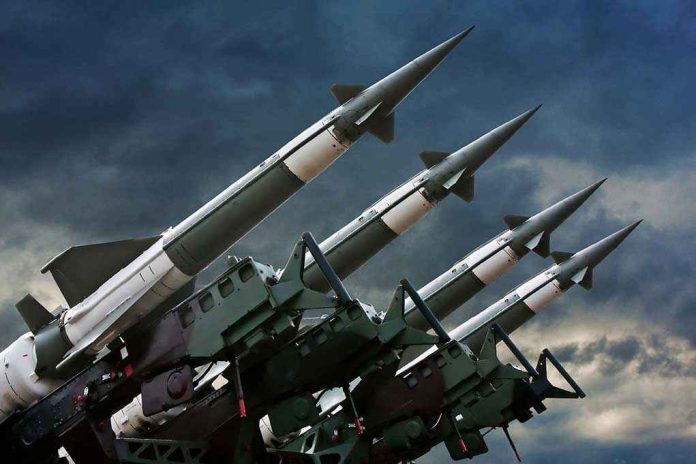
The Biden-era approach to Middle East security faces its toughest test yet, as the US now demands Hezbollah’s full disarmament in exchange for an Israeli withdrawal—a move that could reshape regional power and directly impact American interests and values.
Story Highlights
- The US has issued a strict deadline for Hezbollah’s total disarmament by December 31, 2025, in return for Israeli forces leaving southern Lebanon.
- The Lebanese cabinet has formally approved the plan, but Hezbollah’s leadership remains defiant, raising the risk of renewed conflict.
- This marks the first time an internationally backed, time-bound plan directly ties Hezbollah’s demilitarization to Israeli withdrawal, testing Lebanon’s sovereignty and Western influence.
- Implementation challenges remain immense, with Iran’s backing of Hezbollah and deep divisions inside Lebanon threatening the plan’s success.
US Plan Imposes Tough Deadlines and Conditional Withdrawal
The United States unveiled a detailed proposal on August 7, 2025, requiring the Lebanese government to fully disarm Hezbollah by year’s end. In exchange, Israel would not only cease all military operations in southern Lebanon but also conduct a phased withdrawal of its forces. The plan’s approval by the Lebanese cabinet represents the most comprehensive international initiative since hostilities escalated in 2024, directly confronting the entrenched military and political power of Hezbollah. This approach puts immense pressure on Lebanese officials to act swiftly and challenges Hezbollah’s longstanding opposition to disarmament.
For conservative Americans, this initiative signals a sharp departure from prior globalist strategies that often left US allies vulnerable and rewarded bad actors. By establishing a clear, enforceable timetable, the US aims to force Lebanon’s hand while also holding Israel to a transparent process—provided Beirut delivers on its promises. Yet, these bold terms come as Iran, Hezbollah’s chief sponsor, openly opposes any reduction in its proxy’s capabilities, raising questions about the plan’s enforceability and the seriousness of Lebanese compliance.
Hezbollah’s Defiance and Regional Risks
Hezbollah, a Shiite militant and political group with deep roots in Lebanon and strong backing from Iran, has wielded military power since the 1980s. This longstanding presence has fueled decades of conflict with Israel, most notably in the 2006 Lebanon War. In the wake of major clashes in 2024 and the targeted killing of Hezbollah’s leader Hassan Nasrallah in early 2025, calls for disarmament surged. Despite the Lebanese cabinet’s approval of the US-backed proposal, Hezbollah’s leaders have rejected the plan, vowing to maintain their arsenal and citing resistance to Israel as their core mission. This defiance not only threatens the deal’s viability but also endangers regional stability, especially for Israeli border communities and Lebanese civilians living under Hezbollah’s shadow.
The Lebanese government, while seeking to assert sovereignty and secure international support, faces intense internal divisions. Hezbollah holds significant sway within Lebanon’s political system, making enforcement of the US plan politically risky and potentially destabilizing. Any attempt to forcibly disarm Hezbollah could spark internal unrest, deepen social rifts, and draw Iran further into the conflict. These dynamics illustrate the high stakes for both regional actors and US interests, as failure could embolden other Iranian-backed groups and undermine American credibility abroad.
Historical Precedents and Implementation Challenges
The current US initiative echoes previous efforts, including the United Nations Security Council’s Resolution 1701 in 2006, which similarly called for Hezbollah’s disarmament and Israeli withdrawal. However, that resolution was never fully implemented, hindered by weak enforcement and persistent resistance from Hezbollah. Over the past two decades, multiple ceasefire agreements and diplomatic interventions have failed to produce lasting peace or meaningful disarmament. The new US plan stands out for its detailed, time-bound structure and conditional incentives, but experts warn that the same entrenched obstacles—namely, Hezbollah’s political leverage and Iran’s influence—could derail progress once again.
Western officials and Israeli analysts generally support the plan as a long-overdue step toward stability, while Iranian and pro-Hezbollah voices denounce it as external interference threatening Lebanese sovereignty. Academic and security experts question the feasibility of enforcing disarmament without robust mechanisms or international backing. Ultimately, the plan’s success or failure will hinge on the Lebanese government’s resolve, Hezbollah’s willingness to compromise, and the ability of the US to rally international partners for enforcement.
US proposal calls for Hezbollah to disarm by end of year, Israel to withdraw from Lebanon: report https://t.co/mAuoPP8qw1 pic.twitter.com/0aRN97SbHo
— New York Post (@nypost) August 7, 2025
If implemented, the plan could end the decades-long cycle of violence along the Israel-Lebanon border, curtail Iran’s expanding regional influence, and offer a window for economic and political reconstruction in Lebanon. However, the risk of renewed violence remains high if Hezbollah resists or if internal divisions paralyze the Lebanese government. For Americans concerned with national security, constitutional values, and the consequences of unchecked globalism, the outcome of this initiative will serve as a pivotal test of US resolve in defending its interests and allies abroad.
Sources:
US plan sees Hezbollah disarmed by year-end, Israeli withdrawal
US plan proposes Hezbollah disarmament by year-end, Israeli withdrawal





